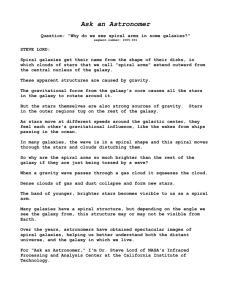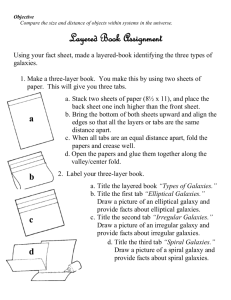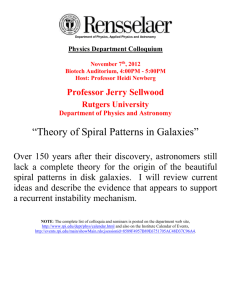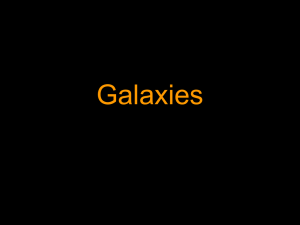PowerPoint Presentation: Spiral Galaxies
advertisement
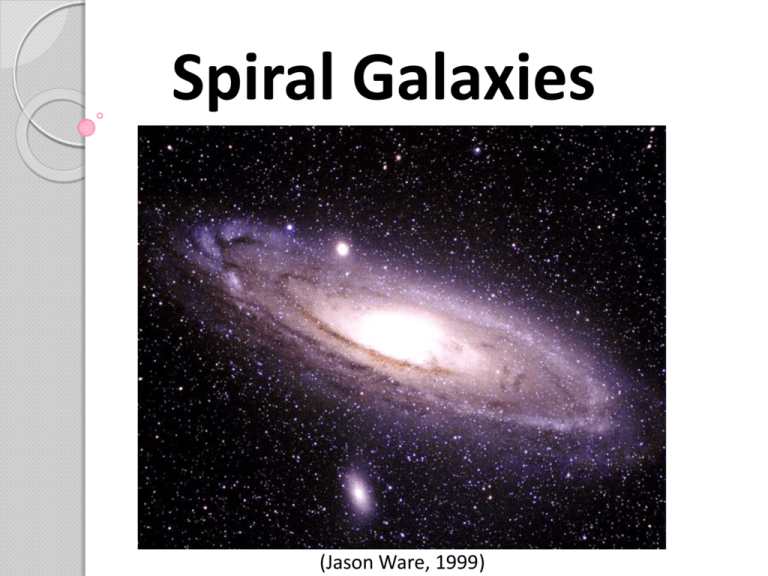
Spiral Galaxies (Jason Ware, 1999) Outline 1. Introduction 2. Basic Structure 3. Composition 4. Morphology 5. How It’s Made 6. Evolution 7. Age/Location 8. Size/Distance 9. Brightness 10.How they are studied 11. Research (willard L, NGC 891 Galaxy) Introduction Galaxy A collection of luminous stars, non-luminous dark matter, in some cases gas and dust, that are separated from other similar structures by distances of 10 kps or more Spiral Galaxy Any member of the Hubble class of galaxies characterized by having a disk and spiral arms (Jones and Lambourne 2003) Basic Structure: •The central bulge • The disk • Stellar halo (Jones and Lambourne 2003) Composition Overall composition • Mass of gas to mass of stars ratio is about 5%-15% • Stars thin out rapidly from the bulge • interstellar medium • mostly HI – neutral atomic hydrogen • HII – ionized molecular hydrogen • interstellar gas is 5% of the total mass • Ratio of strength of hydrogen emission lines to others decreases towards the center (bertin and Lin, 1996) The Bulge • Very dense population of old red stars (Pop II) •takes on the characteristics of an elliptical galaxy • little to no star formation (NASA, M81 Spiral) • Very little traces of gas • low metal content • postulated to have black holes at the center (Inside Galaxies, 1972) The Disk • dominated by young stars and gas (pop I) • star types O-B • Very blue • Contains both HI and HII gas, dust (NASA, NGC 2841) • HII region – about 1/3 distance from center to edge • Neutral hydrogen (HI) peaks farther from the center • Star formation happens in the spiral arms (Inside Galaxies, 1972) Stellar Halo • no star formation • contains very old Population II stars • Spherical in shape • no dust (Andrew Cooper, stellar halo around the Milky Way) • poor metal content • stars form globular clusters and are more sparsely separated than in the bulge • contains dark matter that dominates the mass of the galaxy (Jones and Lambourne 2003) Morphology Different types of Galaxies • ellipticals • spirals • irregulars How to classify a spiral galaxy • size of the bulge relative to the disk • the tightness of the winding of the spiral arms (elmegreen, 1998) (Jones and Lambourne 2003) Sa and SBa – large bulge with tightly wound spiral arms (Jones and Lambourne 2003) Sb and SBb – moderately small bulge and looser wound arms (Jones and Lambourne 2003) Sc and SBc – small bulge and very loose, fragmented arms (Jones and Lambourne 2003) How it’s made... • Big bang • 1 million years to cool down and expand • matter clumps together (H and He) • protogalaxies form • type of galaxy is determined by the initial conditions of the protogalaxy • protogalaxy contracts under gravity • critical limits – condensation and rotation • Spirals form when the contraction is stopped by the rotational radius limit (NASA, Big Bang) (hodge, 1986) Evolution •Once a galaxy has taken shape, action is pretty much done • stars form, they die, and eject heavier materials • gradually dims and reddens •Far off spiral galaxies – looking at the past • younger, bluer, more active, explosive (hodge, 1986) Age • Oldest stars in the galaxies tend to be about 13 billion years old • typical age ~ 12 billion years old • Milky Way ~ 13.6 billion yrs old (+- 800 million) (Pasquini, 2004) • 1 of the first galaxies to be created Location • Galaxies tend to group together into clusters or superclusters • Local group – 30 or more galaxies (Jones and Lambourne 2003) Size/Mass/Distance •10 – 10 solar masses 9 12 • typical diameter - 0.02-1.5 dmw •the thickness of the disk is 1/10 the thickness of the bulge (Jones and Lambourne 2003) Galaxy Andromeda Triangulum Bode’s Sculptor Pinwheel Whirlpool Apparent size (SIMBAD) 190′ × 60′ 70.8’ × 41.7’ 26.9’ × 14.1’ 27′.5 × 6’.8 28′.8 × 26′.9 11′.2 × 6′.9 Distance (SIMBAD) 778 ± 17kpc 730 to 940kpc 3.6 ± 0.12Mpc 3.5 ± 0.2Mpc 6.4 ± 0.5 Mpc 7.1 ± 1.2Mpc Brightness Absolute Magnitude • 109 – 1011 solar luminosities • absolute blue brightness is -16 to -23 Galaxy Andromeda Triangulum Bode’s Sculptor Pinwheel Whirlpool Apparent Magnitude (SIMBAD) 3.44 5.72 6.94 8.04 8.31 8.36 (Jones and Lambourne, 2003) How to study Isophotes – closed curves connecting points of equal apparent surface brightness Can be used to detect shape and luminosity of the galaxy Stellar Spectroscopy - by looking at the thermal spectrum of the galaxy, can determine what a galaxy is made of and it’s temperature Rotation curves – rotational speed vs radial distance to determine the mass Computer modelling – evolution and kinematics (Jones and Lambourne 2003) Research Astronomy magazine – Astrophysicists reports first simulation to create a milky way-like galaxy • results support the “cold dark matter” theory • The evolution of structure in the universe is driven by the gravitational interactions of dark matter • previously, simulations had bulges too big compared to disk • After the big bang, gravity pulled dark matter together which grew into clumps that made “gravitational wells” to capture the matter that form galaxies (University of California, Simulation) Astronomy Magazine - Milky Way's spiral arms are the product of an intergalactic collision course • Dwarf galaxy Sagittarius loaded with dark matter collides with the Milky Way • force of impact sends stars streaming in long loops • stars tugged outward and become ringed arms • spiral arms emerged 2 billion years ago due to this collision • another collision due in 10 million years (University of California, Spiral Arms) References Aller, L. 1972. ‘Galactic Explorations’. In: Harlow Shapley, Cecilia Payne-Gaposchkin. Galaxies. 3rd ed. Cambridge: Harvard University Press. Aller, L. 1972. ‘Inside Galaxies’. In: Harlow Shapley, Cecilia Payne-Gaposchkin. Galaxies. 3rd ed. Cambridge: Harvard University Bertin, G and C. C. Lin. 1996. Spiral Structure in Galaxies. Massachusetts: MIT Press. Elmegreen, D (1998). Galaxies and Galactic Structure. New Jersey: Prentice Hall. Hodge, P. (1986). Galaxies. London: Harvard University Press. Jones, Mark H. Lambourne, R. (2003). An Introduction to Galaxies and Cosmology. Cambridge: Cambridge University Press. Cooper, A. P., Cole, S., Frenk. (2010), Galactic stellar haloes in the CDM model. Monthly Notices of the Royal Astronomical Society, 406: 744–766. doi: 10.1111/j.13652966.2010.16740.x. Viewed at: Oct. 4, 2011 <http://www.physorg.com/news197044028.html> NASA. Big Bang Expansion. Viewed at: Oct 4th, 2011. <www.daviddarling.info/encyclopedia/B/Big_Bang.html> NASA. Fuzzy Wuzzy Galaxy. Viewed at: Oct 4, 2011 <ww.news.nationalgeographic.com/news/2011/02/pictures/NGC-2841>. Last Accessed: 4th Oct 2011. Pasquini, L, Bonifacio, P, Randich, S, Galli, D, Gratton, RG. 2004. ‘Beryllium in turnoff stars of NGC6397:early Galaxy spallation, cosmochronology and cluster formation’. Astron.Astrophys. 426 (2004) 651-657. viewed Oct 4, 2011. <arXiv:astr-ph/0407524v1> SIMBAD. M-33, M-31, M-81, M-51a, Caldwell-65, M-101. Viewed at: Oct 4, 2011. <www.simbad.u-strasbg.fr/simbad/> University of California. (2011). Astrophysicists report first simulation to create a Milky Way-like galaxy. Last accessed 4th Oct 2011. <http://www.astronomy.com/en/NewsObserving/News/2011/08/Astrophysicists%20report%20first%20simulati on%20to%20create%20a%20Milky%20Way-like%20galaxy.aspx>. University of California. (2011). Milky Way's spiral arms are the product of an intergalactic collision course. Last accessed 4th Oct. <http://www.astronomy.com/NewsObserving/News/2011/09/Milky%20Ways%20spiral%20arms%20ar e%20the%20product%20of%20an%20intergalactic%20collision%20c ourse.aspx.> Ware, J. (1999). M31: The Andromeda Galaxy. Last accessed: Oct 4, 2011 <www.apod.nasa.gov/apod/ap991114.html>. Last accessed 4th Oct 2011. Willard L. NGC 891 Galaxy. Last accessed 4th Oct 2011 .<www.unews.utah.edu/news_releases/u-celebratestelescope039s-039first-light039/>.


